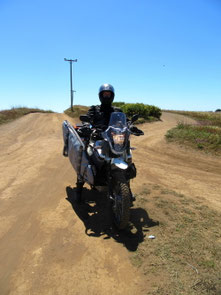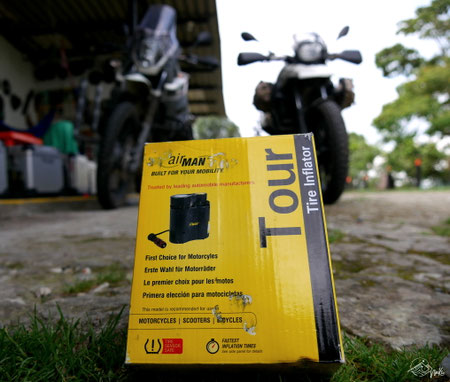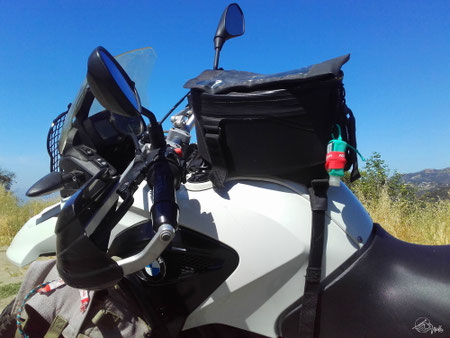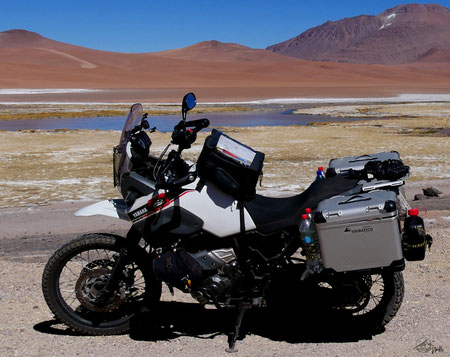Reviews motorbike equipment
On this page, we report about our experiences with our motorbike equipment. This part will be updated and completed from time to time.
Surfrack motorbike - Yamaha Ténéré

The surfrack for the Yamaha Ténéré, was designed and manufactured by our friend Markus (thanks again for your help, the rack is great!). In Advance, we had met in his workshop to discuss the project "Surfboard rack for the Yamaha".
Both of us had no idea how the rack should look like, what exactly it should be able to do and what it has to withstand. I only had a few pictures from the internet. But these were mostly without bigger luggage or panniers.
How wide should the rack be, for having enough space for the 38-liter pannier between the bike and the surfboard? What weight should it withstand? Where should we mount it? Shall we make it straight or u-shaped? How far does it have to be away from the bike so that I can still get my feet on the ground? Will I still be able to drive through curves like I am used to? How do I attach the board so that it does not fly away on the highway? Questions over questions.
A test ride was unfortunately not possible, as this is estimated to be prohibited in Germany. All I could do was to take a small ride in a parking lot of a nearby school on an early Sunday morning. But without a board.
After less than a week the rack was welded and mounted. With 5 screws the rack can be disassembled and stowed away in minutes. We deliberately wanted a dismountable rack, so that we would not have any problems with shipments etc.
The rear rack is screwed on where normally the footrest for the passenger is mounted.
The front part is screwed directly to the engine guard of Hepco and Becker. The 4 holes needed to screw the rack to the protection bar were already drilled at the factory.
The board itself is fastened in front and in the back each with a tension belt and I control this regularly.
After more than 20.000Km with the surfboard, here is my conclusion:
At the beginning it took some time getting used to. Especially in Chile, where we had very strong cross wind on the highway. I mostly drove in a slanting position while going straight ahead to fight against the wind. It was fun when big trucks came towards us. I knowingly always clung on to the handlebars and took some cover so that the oncoming wind didn't blow me off the bike. Also, Gravel- or Dirt roads were a real challenge in the beginning. I have never ridden on gravel, sand or pothole tracks before and of course not with a surfboard by my side. So, on the way to the first spot in deeper sand I lay down directly on the rack with the board. Luckily, 2 men came to my rescue. The bike is so heavy that you need at least 3 people to set it up if it is on the side of the rack. Thereby the rack was bent, which we fortunately could straighten again afterwards. The board was not so lucky (see travel blog entry Chile).
With the kilometers I gained experience and got used to my excess width and riding with the board. No matter if it was raining, hot temperatures, windy, bad road conditions, traffic chaos in big cities, overtaking maneuvers or winding mountain passes, I could ride almost as if I was riding without a board. Our maximum speed was 100Km/h.
For further questions about the rack you can always contact us via our e-mail address info@niuka.de or via social networks.
Airman Tour Air Compressor

We saw an air compressor in the shop by chance during our last purchases for the bikes and bought it directly. Greenhorns as we were, an air compressor was never planned to be taken on the trip! We couldn´t do without him now and had used it very often! In Chile the gas station network was very good, there were a lot of Copec gas stations where you could check or adjust the air pressure. In Peru, Ecuador or Colombia, or also Central America, there was a relatively good filling station network, but often the possibility to check the tire pressure was missing. We also noticed that the displays were often not accurate. Thus, we have relied exclusively on our compressor since entry to Peru and used it. The operation is very simple.
The pressure hose is screwed onto the tire valves and the tire pressure can be read and/or adjusted. The display is in PSI and bar, is very easy to read and goes up to a maximum of 6 bar or 80 PSI.
The compressor has a 12V standard plug for cigarette lighter with an approx. 2.80m long cable. If we put both bikes next to each other, we can inflate all four tires one after the other.
Due to the small packing size it fits easily into our 38-litre aluminum pannier with further tools, spare parts, etc.
Included in delivery are the instruction manual, a bag, an adapter for bicycle tires, an adapter for balls, as well as an adapter for inflatable toys. The adapters are stored in a small compartment on top of the compressor.
Conclusion: Small, practical and worth every cent.
Enduristan Sandstorm 4S

For the BMW G650GS we decided to take the tank bag Sandstorm 4S from Enduristan. The inner compartment and the map compartment are 100% waterproof. We can confirm this after many hours of driving in heavy rain in Central America. The "small" tank bag offers the possibility to increase the volume steplessly from 7 to 12 liters with a velcro fastener.
The tank bag consists of a map compartment, a large inner compartment and a removable mesh pocket. In addition, the bag has a waterproof cable bushing.
We are carrying the following items inside the bag: accessories system camera, sunscreen, sunglasses, hand sanitizer, small water bottle, leatherman, pen and notepad, wallet, mobile phone, MP3 player, headlamp, toilet paper, carabiner, adapter for on-board power socket (BMW).
The tank bag is fastened to the bike with four buckles and is bombproof. Even fully loaded, nothing wobbles or slips. To refuel, you could also loosen the upper two buckles and fold the bag away towards the seat. But since the tank of the GS is at the back, we can save ourselves this step.
The map compartment is small, documents or maps will fit in here. However, these must be folded or creased to at least one third of a DIN A4 page.
Conclusion: We can highly recommend the tank bag. It is small and handy, can be enlarged if necessary, is super processed and even after more than 20.000Km functional as on the first day.
Enduristan Sandstorm 3E

For the Yamaha Ténéré with its curved tank, we chose the tank bag Sandstorm 3E from Enduristan. The inner compartment and the map pocket are 100% waterproof. The two outer compartments, however, are only partially waterproof. Therefore, we have wrapped their contents in bags. In Costa Rica and Nicaragua, we had a lot of rain and even after hours of driving the maps and other documents as well as the contents of the large inner compartment were completely dry. We often used the possibility to increase the volume steplessly from 13 to 20 liters with the help of velcro fasteners. Especially in areas where the next supermarket was not around the corner, we were able to stock up even more supplies.
The inner compartment is a space miracle: it contains a removable mesh pocket in the lid, with Velcro, detachable areas and the large middle compartment. There is room for our travel documents, headphones, pen and notepad, firestone, bivi, hand sanitizer, 2 headlamps, small backpack, tent lamp, wallet, toilet paper, Leatherman, charging cable and accessories for actioncam, sunglasses, sunscreen, small water bottle, cable lock, adapter plug for USB and 12V plug, muesli bar and snap hook.
Folded cards and documents up to max. DIN A4 size have their place in the large card compartment.
The tank bag is attached to the bike with four buckles and is bombproof. Even fully loaded, nothing wobbles or slips. To refuel, the two upper buckles are released, the bag is folded away towards the seat and the tank nozzle is freely accessible.
We see a problem point in the map compartment. When accessing the large inner compartment, the map compartment is bent. Exactly at this kink we had a crack in the map compartment after about five months. Fortunately, this is fixed on the tank bag with two velcro fasteners and can be replaced. The company Enduristan was kind enough to deliver a new map compartment to Mexico. Thanks again for the nice contact and the new map compartment.
Unfortunately, the tank bag presented here (purchased in 2018) is missing a waterproof cable bushing. This would be desirable to be able to load more things in the tank bag while driving.
Conclusion: We are more than satisfied with the tank bag and can recommend it without restriction. You can rely on the waterproofness, the solid and robust workmanship as well as the space available on long or short trips.



















